CAPTIONS: all photos taken by Field School
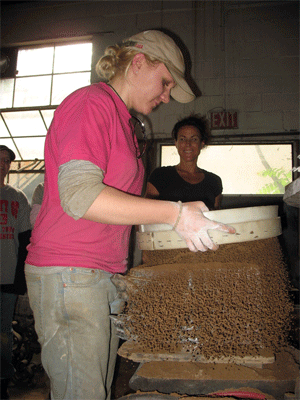
Lindsay, the author, sifts sand to fill the mould at Dean Anderson's foundry
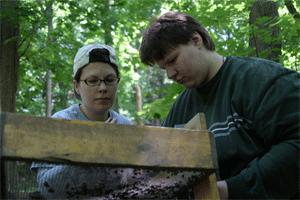
Screening continues to be important at the East Bank House as demonstrated by Lee (our field lab coordinator) and Nikki.
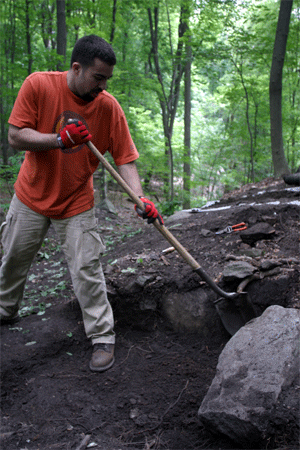
Dan refines a filled in channel at the north-eastern edge of the Pond.
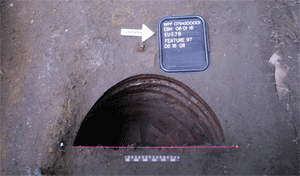
A close up of a barrel cistern, termed Feature 97 located to the west side of the East Bank House.

Select on photograph to enlarge
Dr. Sam explains the barrel cistern to visitors at our "Days at the Foundry" open house over the weekend.
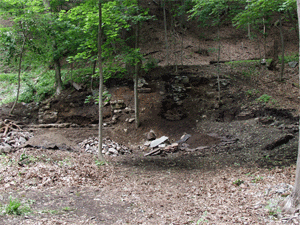
Select on photograph to enlarge
An overview of the northern room of the Boring Mill, looking west. Notice the piers for the water flume above a foundation wall.
|
Hello, my name is Lindsay Kiefer and I am an undergraduate at Michigan Technological University, majoring in anthropology. This past Spring semester, I worked in the Archaeology Lab as a Lab Assistant. There I heard about the West Point Foundry and how students could learn the procedures of archaeology. Four months later, I find myself in Cold Spring, NY working alongside my archaeology professors to learn more about this significant historical site.
This week was one of the busiest and most important weeks of the term because of our first open house for the 2006 summer season. This week we also had a field trip to Dean Anderson’s foundry shop, as well as the last Haldane 4th graders coming for a visit on Thursday. All in all this week made for a very busy yet satisfying one.
The open house on Saturday and Sunday went very well. In case you missed it, there will be another in July on the 16th and 17th. The “Days at the Foundry” was a great opportunity for around 100 people to learn about the site and for us to share what we have excavated and hear what they had to say. In addition to the archaeology, Haldane’s 6th grade class provided 4 murals and several volunteer guides who came for orientation on Thursday and early on Saturday. Haldane has been working with Scenic Hudson, Michigan Tech, and Dean Anderson to learn about local history this year. About ten students from the 6th grade helped out by giving tours and discussing their projects. I was pleasantly surprised by how many people really took an interest in this industrial site.
Monday the crew had a field trip to Dean Anderson’s foundry shop, called Super Square Iron Work. With the help of his assistant Amy, Dean gave us a few demonstrations on how to make a mold out of sand. The process also includes filling the mold with melted aluminum, and when the aluminum has cooled, dumping the sand mold into a wheelbarrow. After the sand falls off you have the finished project. I also got to participate in the fun and make a mold which turned out pretty good from my inexperienced point of view. Dean’s partner Brett also gave us a quick blacksmithing demonstration on the finer points of how to shape iron into a fire poker, and shaping metal in general.
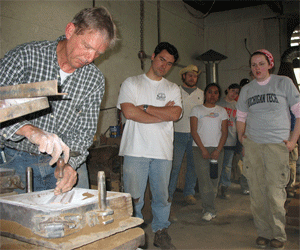
Dean Anderson pulls a wooden pattern from a sandcast mould as students and volunteers watch with keen interest.
This has been a busy week for all of us, including the crew excavating at the Battery Pond. Dan and Cameron have been exposing the channel that went from the Blast Furnace to the Battery Pond as well as mapping the pond, which is in itself a big undertaking because it is such a large area. In the process they have run across a few pipe bowls, nails, slag, and a large iron feature (feature is an archaeological term for a human made object that is technically an artifact but too large, or situated in such a way, that it cannot be moved). In so doing they hope to learn about the interface between the Blast Furnace and the Battery Pond, and to expose any walls, structure, and possible ways that the Brook fed the Pond.
Bode and Craig have been excavating at the Boring Mill. This week they finished exposing the north and south Wall of the Boring Mill. Finds for the week have consisted of files, forge collars, bolts, washers, chisels, and the basic assortment of tools that you would find in a machine shop. They wish to continue identifying features in the Wheel Pit area and adjacent rooms. Their next project is to map the North Room.
Other crew members have been active at the East Bank House. Starting on the western side of the foundation are the two units that I have been working on with Sam, one of the professors from Michigan Tech. Excavation units 2.7A and 2.7B are both open, however much of our focus has been on 2.7B which is the unit nearest the house foundation. 2.7A has a 2cm thick lead pipe running through it that we believe was a gas pipe, and 2.7B has unearthed a large barrel (see photograph). The barrel is approximately 1m 5cm tall, and it may have historically correlated with the clay feature underneath, apparently a cistern. This unit has produced many interesting artifacts, such as ceramics, glass, pipe stems and bowls, nails, coal, and even a toy jack. Our next step after we reached the bottom of the barrel this week is to bisect the unit from where we have bisected the barrel and excavate the unit to bring the barrel’s iron bands into profile. This will also help us understand the relationship of the barrel to the clay feature.
North of the East Bank House, a large portion of a wall has been uncovered. As last year’s E.U. (excavation unit) 4.10 contains a section of this wall, it was re-excavated this week. With E.U.’s 3.10A, 3.9A, and 3.9B, unearthing this middle portion of the wall allowed the students and visitors to see its extent. In 3.9A where Shannon, Vanessa, and one of our volunteers Tricia worked this week they found nails, coal, glass, and ceramics. They exposed the plan of the entire wall this week, and another possible posthole. While exposing the wall they discovered a distinct gravel patch in the southern wall different from the soil in the rest of the unit, so 3.9A is being put on hold until 3.9B gets down to the same gravel layer.
Cal and our other volunteer Doug worked in unit 3.9B this week. 3.9B is nearest to the north foundation of the house and also contains a large iron slab which abuts the house foundation and this stone wall. They have been exposing the iron feature to see its extent, and possibly its construction. It is probable that the iron feature was used to drain water from the house, keeping rainfall from flooding the basement. Lots of nails, brick, and ceramics have been found in this unit.
The smallest unit 4.8B, where Steph has been working, is 1x1m. It is east of the foundation and between the Brick Patio and the foundation. Steph finished level 4 this week and started on level 5. She has been trying to find the intersection of the Patio and the house foundation. This unit has produced many large sherds of ceramic.
Last but not least is 3.7A, the unit inside the house that Nikki has been working on. Nikki has been finding lots of sheet metal, melted glass, window glass, nails, mortar, plaster, bone, bits of ceramic, and hinges. Her purpose is to find a layer of building material, cultural artifacts, and burned material (charcoal and ash). Nikki hopes to find the original cellar floor as well as the depth of the foundation. This week she finished levels 2-5.
These have been the major projects of the week and it came to a close on Sunday with the end of Open House. Another ending was saying goodbye to our two volunteers Tricia and Doug who left at the end of this week. After two weeks with us, they have already become good friends with all of the crew and valued members of the crew. They will be missed.
Lindsay Kiefer
|



